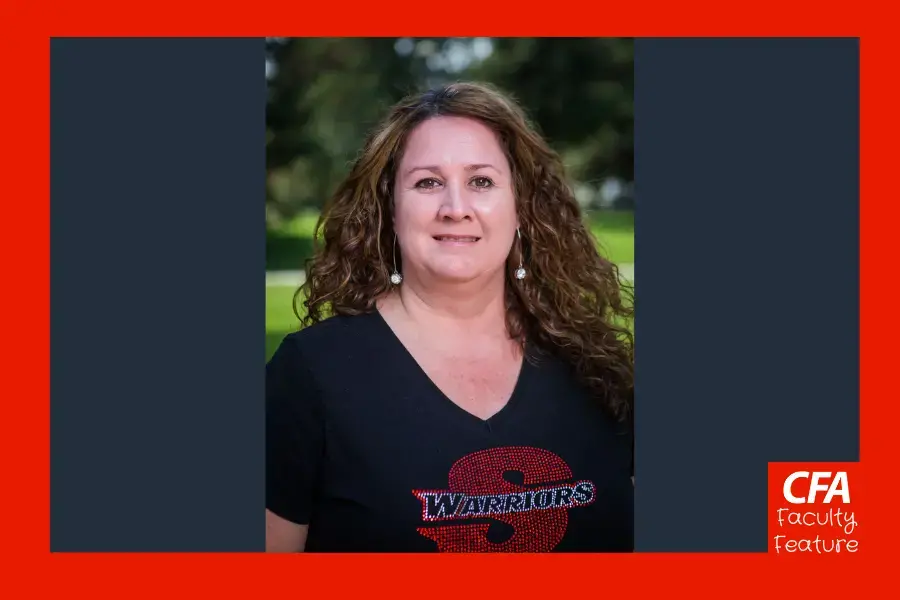Faculty Feature: The Right Counselor Ratios Make a Difference at CSU Stanislaus
Our contract campaign demand of a 1,500-to-1 student-to-counselor ratio is the norm for Counseling Lead Jennifer Staffero at CSU Stanislaus.
“Before, when we weren’t at that ratio, there were only a few of us counselors, and all we were doing was seeing clients all day. We couldn’t even go to different events on campus to do outreach.”

Seeing up to eight clients, or students, a day gave her little breathing room. Seeing five clients a day allows her to do research and be more deeply prepared for her client sessions.
“We have high-risk time, too,” Staffero said. “We have time on our schedule where we get to stay open and available.”
During COVID-19, the two additional counselors they hired allowed them to improve their ratio. They also expanded with a clinical case manager and a counselor for the Stockton campus. Even with these necessary resources, more is required. “Even though we have a super great ratio, we’re still having to see students every three or even five weeks,” said Staffero. “When we get really busy, you can only see them once a month.”
Staff within the center have expanded their skill set as well. Staffero has a colleague who is beginning equine therapy training courses, and another has become an eating disorder specialist. These are all services they hadn’t had before. Another colleague became so good at EMDR therapy that Staffero regularly sends referrals.
While at Stanislaus State, she has noticed that students want to come to counseling and put in the work, taking to heart what they talk about in session. “It’s so nice to work with the population we have,” said Staffero.
Prior to working at Stanislaus State, Staffero worked in a clinical center where she saw clients with immediate needs but little opportunity for follow-through. Working long, grueling hours with patients desperate for support meant that every day was a series of crises. She wanted to provide ongoing support, not just smother fires.
At the first opportunity for a full-time position, Staffero was happy to apply and was delighted to be hired full-time. “It’s super gratifying to see all the changes that students make, they put that effort in,” said a beaming Staffero.
She brought that same energy to her work with CFA. Former CFA Counselor Committee Chair and current San Francisco State Counselor Susan Chen remembers Staffero’s presence in meetings.
“It has been a pleasure getting to know Jennifer, who has such a warm personality. What has always stood out is that all CSU Stanislaus counselors attend our monthly counselor representative meetings en masse in large part due to Jennifer’s support and encouragement to connect with CSU counselors in our efforts to enhance mental health, well-being and working conditions. We were excited when she joined our Counselors Committee this past term,” Chen said.
Staffero explains that her therapeutic approach focuses on self-compassion because it is at the base of different types of therapeutic approaches. Whether it’s cognitive behavioral therapy or family system therapy systems, they all incorporate mindfulness training.
When she started working at CSU Stanislaus, “I noticed that so many students just in general, a lot of people have that critical voice, if they made a mistake or they did poorly on an exam, or they get negative messages from their families.” Staffero saw firsthand that if you keep telling yourself you’re not good enough, you will eventually believe it.
One way she instilled mindful awareness was through the development of a program for student-athletes. Using the RESET: Resilience and Enhancement in Sport Exercise & Training methodology, Staffero is able to offer “self-compassion but repackaged to help student-athletes with that critical voice.” Helping athletes with their intrusive thoughts and the negative voices that get in the way of their athletic performance, etc. It’s one of many ways that Staffero makes therapy approachable.
The COVID-19 pandemic caused a distinctive shift in counseling services. Without a director, the Stanislaus team quickly came up with policies and procedures aligned to the evolving needs of undergraduates. As students returned to campus it was clear to Staffero that they were having a harder time connecting. So much of her work has become about supporting the rebuilding of the social fabric on campus.
Another way that the counseling center and Staffero support student access to therapy is to keep students on campus for counseling instead of referring out to private practitioners. For many students, referring out carries the risk of unsupportive parents and caregivers finding out about therapy: seeking therapy is still stigmatized. In some cases, students are heads of household so getting therapy on campus is more convenient. Overall, having mental health services on campus gives some students an anchor as they navigate the demands of their undergraduate experience.
While many may be hesitant to start therapy, Staffero reminds anyone who is interested that “they can always change counselors because it is a lot about the connection. If you have a good connection, you’re going to do better work with your person.”
She sees her own identity as a source of encouragement for students. As a first-generation female, light-skinned Latinx-identified person, she knows that those who identify with her need support. With over 73 percent of students being first-generation college students at CSU Stanislaus, many don’t feel like they belong.
“I think it’s like a lot of clients are feeling like it’s self-care. This is my self-care to come to therapy, which I love. I think it’s the right attitude.”
For Staffero, being effective as a counseling center is “about having a clear vision for how you want to do therapy and then making sure the administrators are matching that.”
Join California Faculty Association
Join thousands of instructional faculty, librarians, counselors, and coaches to protect academic freedom, faculty rights, safe workplaces, higher education, student learning, and fight for racial and social justice.